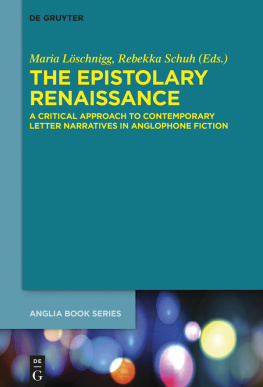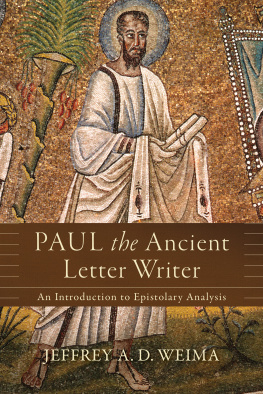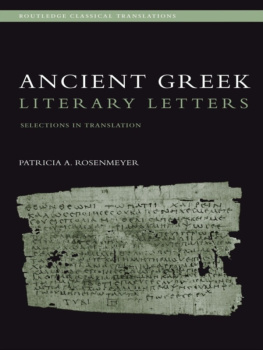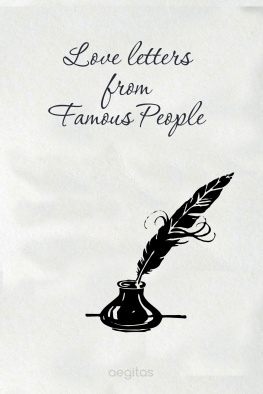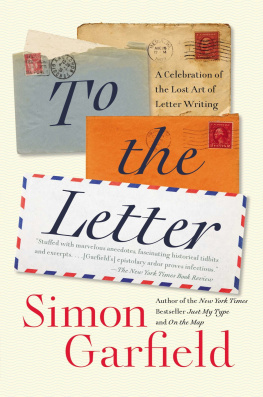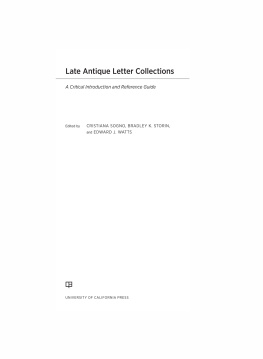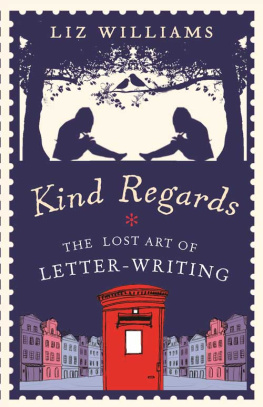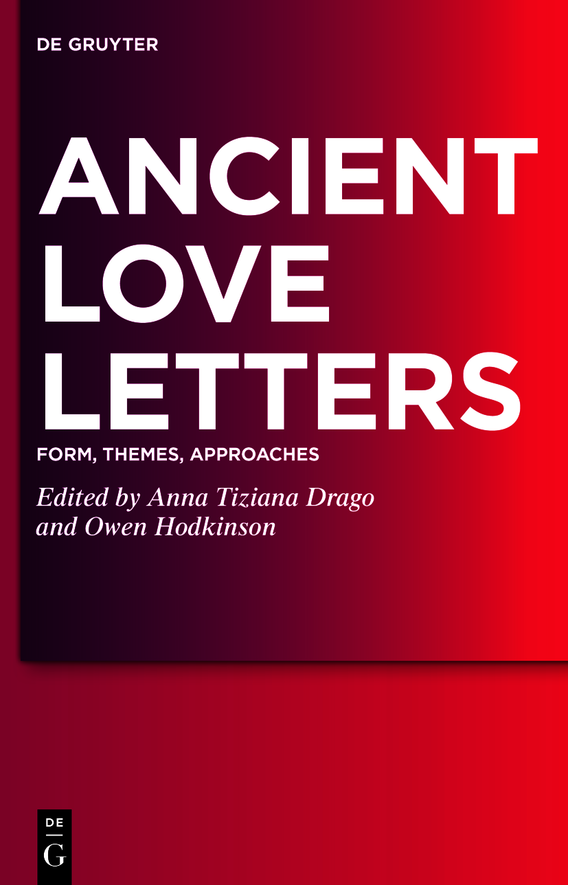The Deutsche Nationalbibliothek lists this publication in the Deutsche Nationalbibliografie; detailed bibliographic data are available on the Internet at http://dnb.dnb.de.
I History of a corpus: loss, lack and finding love again?
A generally well-read person of our era, not trained in classics or the study of antiquity, would probably be surprised to learn that love letters are not particularly prominent among classical literary works, nor considered an important field of study by most classical scholars. But this is not because the textsand thus potentially the genredo not exist: rather, it is the result of a combination of sometimes quite unrelated facts and phenomena of the centuries between antiquity and the present.
The fact that the most famous author of letters on amatory themes, Ovid, was out of fashion with classical scholars during a long period, in which his approximate contemporaries received fulsome modern scholarly attention, is one consideration; related to this is the fact that his Heroides, the amatory-epistolary work in question, was out of fashion even among Ovidian scholars until recent decades. That these classical amatory letters are also elegiac poems on mythical themes, and thus studied in different contexts from that of the love letter, and that they are attributed to abandoned lovers at the end of a failed love affair are coincidences that lead to potential mismatches between classical examples and modern ideas of what constitutes a love letter. Other Latin examples are fewer and further between: Propertius 4.3, doubtless influential for the Heroides, is an elegiac epistle between two lovers, but is something of a novelty for its epistolary form in a book of elegies; expressions of love, including but not often solely from husband to wife (i.e. often addressing the rest of the family too), can sometimes be found in Ciceros and Plinys letters, while the homoerotic epistolary exchanges between the Emperor Marcus Aurelius and his former tutor Fronto have been neglected in the modern era because of contemporary prejudices.
Meanwhile, among all the less familiar books of classical letters with amatory and erotic themes, completely different sets of circumstances have led to an even greater neglect than the Heroides suffered. To take just one example, Philostratus (3rd Century AD, Greek, prose) Erotic Epistles, addressed to anonymous beloved women and youths, and full of allusions to earlier Greek and perhaps Latin erotic and other literature: Philostratus letters were certainly available to readers of Greek and to would-be imitators and translators almost continuously in MSS and then printed editions, through Late Antiquity and Byzantium, tells its own story about one very important factor in their neglect from the Victorian era till recently (this factor in particular is more or less unique to Philostratus, and not relevant for several other epistolary texts also neglected). Another important, unrelated phenomenon condemning Philostratus, his Greek contemporaries Alciphron and Aelian, and their successors Aristaenetus and Theophylact Simocatta (7th century AD) to obscurity is simply the periodisation and disciplinary boundaries of the study of classical literature: until recent decades, even Hellenistic Greek literature was a very unfashionable object of study, let alone Greek literature of the Roman Empire; very recent and substantial growth in scholarship on Imperial Greek literature means that Philostratus and his contemporaries are now gradually coming to prominence again. Aristaenetus and Theophylact, unfortunately, have not yet been reclaimed by the classical canon, and in many countries, scholars studying their works would not even belong to the same discipline as the classicists, despite the obvious influences and similarities, being rather too late and thus classified instead as part of Byzantine studies.
Finally, the historical separation between specialists in Latin and Greek literatureoften far starker than the analogous separation between scholars of ancient Greek and Roman history can afford to be once their histories start to intertwine and then become oneis partly to blame for the fact that very few scholars have until now sought to study the love letter in antiquity across these boundaries. There is still much work to be done in identifying genres or subgenres, looking for commonalities and generic conventions that cut across the languages and eras, and seeking evidence of bilingual culture and the influence of shared real epistolary conventions, as well as noting direct intertextuality between particular literary letters. The more understandable separation between scholars of literature and of documentary texts (such as real letters), to be attributed in part to the relatively small number of surviving real letters that might be labelled as erotic, is nonetheless regrettable in its consequences for our understanding of a body of texts that has some shared conventions and forms of expression, and no doubt mutual influence between literary production and letters actually sent to love interests. The resistance by many scholars to the idea that Greek literary authors of the Roman Empire would choose to allude to earlier Latin literature is another quirk of fate that has nothing to do with love letters specifically, yet happens to have delayed progress in examining some potential intertextual relationships and broader generic models among our objects of study, given that most of the Greek examples are later than most of the Latin ones. When we move into the later reception history of our texts, the same separations are at issue: naturally, not everyone who specialises today in, for example, Renaissance Neo-Latin or vernacular love poetry, and who will be very well aware of a classicising genre of love letters full of intertextuality with the Heroides, will have heard of Philostratus and his peers, or necessarily have studied ancient Greek in order to be able to look at this side of the tradition. This problem re-combines with the severe neglecteven by classicistsof these particular Greek texts, meaning that the non-specialist who might have reason to investigate further cannot, because we lack for many of the Greek erotic letters sound textual editions, in-print, comprehensible translations into several modern languages, full commentaries, or much by way of scholarly interpretation.
II A remedy for love
These several, largely unconnected phenomena can be seen as in many different ways responsible for the unfortunate fate of most of our texts, which we outlined at the beginning of the chapter. They also explain the lack of a potential light being shed even on the better-off texts, such as the Heroides, by a wider understanding of their ancient contexts. But before weto a large extent self-selecting scholars, already bound to champion the merits of our particular niche textsbecome too impassioned by these injustices, and claim that a revolutionary approach to all traditional disciplinary boundaries within and beyond classics is needed to solve them, some caution is needed.
We are certainly not suggesting that every one of the remedies implied in the previous section will necessarily bear substantial fruit for all of the texts, or that such remedies will be equally valuable for all of them. It is rather the case that different questions should be asked, without anticipating the answers, questions that have gone unasked for epistolary texts while scholars of other forms of erotic discourse in antiquity and beyond have long been asking them: specifically, questions about genre(s) and subgenres; about relationships between Greek and Latin examples of the form at all levels from the macro (e.g. a unified Graeco-Latin love letter genre vs. distinct traditions) to the micro (e.g. specific allusions between examples of the genre). We propose asking questions about 1) relationships between literary traditions, rhetorical and technical prescriptions and models, and real-life practices in every direction and combination; 2) relationships between the erotic in the modern sense and the broader sense of Greek


